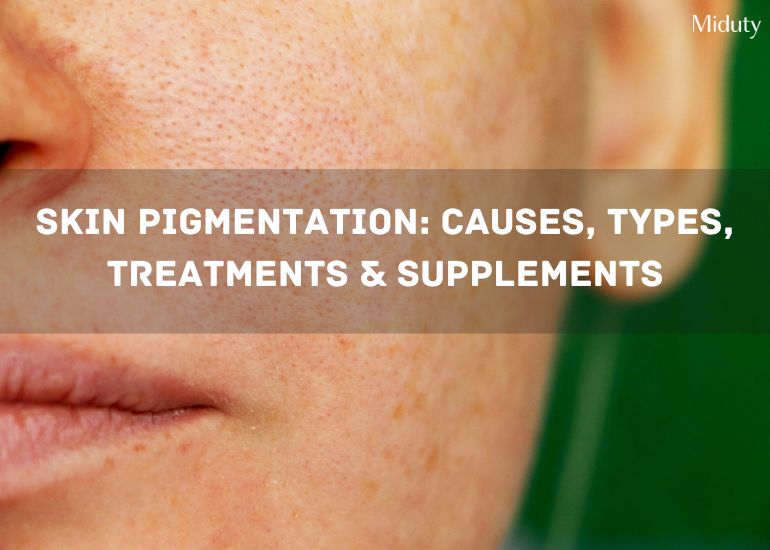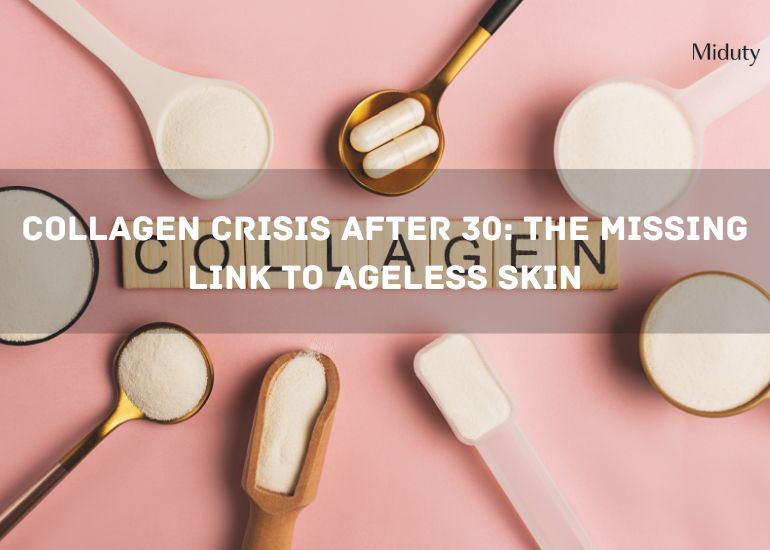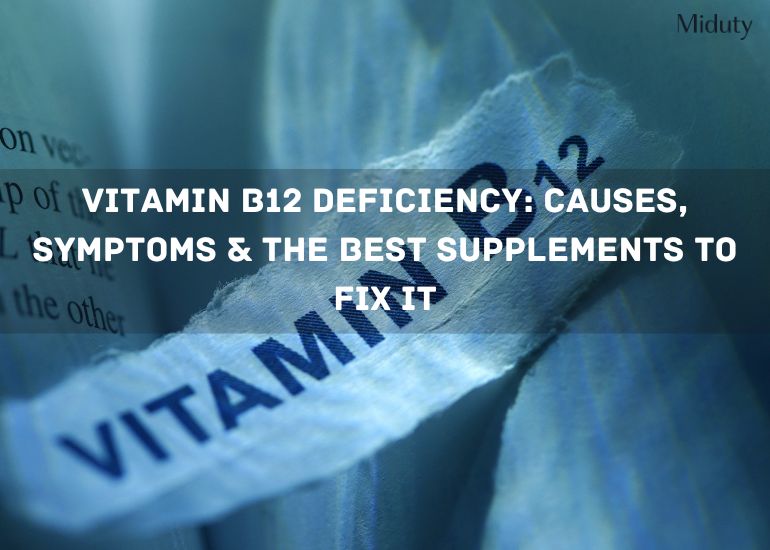
Skin Pigmentation: Causes, Types, Treatments & Supplements
Key Takeaways
1) What is Skin Pigmentation: It refers to the discoloration of skin because of melanin imbalance. There can be different types of skin pigmentation, including hyperpigmentation (excess melanin) and hypopigmentation (lesser melanin).
2) Types of Pigmentation Disorders: Based on two classes of skin pigmentation - hyperpigmentation and hypopigmentation, there are various types of this condition including melasma, freckles, albinism, vitiligo, and more.
3) Lifestyle Changes and Supplements as Skin Pigmentation Treatment: Adopting some simple lifestyle changes can make your pigmentation go away. Some of these habits are applying sunscreen daily, adding antioxidant-rich foods to the diet, not-so-harsh skincare regime, and hydration.

At some point in time, we all have noticed dark patches, uneven skin tone, or blotchy areas - especially on the face. It is so frustrating to see such changes popping up. There can be multiple reasons behind it such as excessive sun exposure, or stressful times. For some of you, these dark spots might be a reminder of your acne that doesn't seem to fade, while for some it might be sudden pigmentation because of hormonal shifts.
But you're not alone in this! The good news is, that there are many skin pigmentation treatments that you can go with to let go of this condition.
In this blog, we will talk about what skin pigmentation is along with the types of skin pigmentation disorders and the ways to treat the condition. You will be able to understand your skin better so that you can choose the right ways to regain your smooth, even-toned skin.
Table of Contents
2. What Causes Skin Pigmentation?
4. How to Prevent Skin Pigmentation?
5. Supplements for Skin Pigmentation
6. Conclusion
8. References
What is Skin Pigmentation?
Skin pigmentation refers to the natural pigment or color of our skin which is defined by melanin present in our skin cells. This pigment (melanin) is made by specific cells called melanocytes. The production of melanin in our skin cells is influenced by genetics, certain medical conditions, or sun exposure. [1]
Changes in the melanin pigment cause disorders related to it. In the cases where skin pigmentation becomes uneven or excessive in some areas of the skin, the condition is called hyperpigmentation. In some people, there might be less melanin production as well, resulting in hypopigmentation.
Also Read: What is Pigmentation on Face?: Reasons & Effective Home Remedies
What Causes Skin Pigmentation?
Many of us believe that skin pigmentation on the face is solely due to sun exposure, but that's more of a myth! While sun exposure is a major factor, several other factors contribute to skin hyperpigmentation. In reality, skin pigmentation can be triggered by various internal and external factors that come in between melanin balance.
Identifying these triggers at the early stages can help in choosing the right skin pigmentation treatment. Some such causes of skin pigmentation include: [2]

|
Causes |
Description |
|
Sun Exposure |
UV rays trigger melanin production in skin cells, leading to sun spots and skin pigmentation on the face or other body parts exposed to the sun. |
|
Skin Inflammation |
Skin inflammation can make your skin appear darker. People with darker skin tones tend to have hyperpigmentation more often after having inflammation. Inflammation may appear as acne, lupus, eczema, or any injury caused to the skin. |
|
Hormonal Shifts |
Conditions like pregnancy, menopause, or thyroid dysfunction can also cause melasma and skin hyperpigmentation or hypopigmentation issues. |
|
Poor Diet |
A diet high in sodium, sugar, inflammatory foods, preservatives, or additives can also cause skin pigmentation on the face. |
|
Aging |
As the skin ages, it becomes more susceptible to uneven skin pigmentation resulting in dark patches, or age spots. |
|
Certain Medications |
Certain medicines like antimalarial, and antidepressants, can also cause skin hyperpigmentation. In such cases, the spots or skin might appear grayish. |
|
Genetics |
Family history plays a role in the development of some types of skin pigmentation disorders such as freckles or vitiligo. |
Types of Skin Pigmentation Disorders and Their Treatments
Broadly, skin pigmentation on the face can be classified into two, which are:
- Hyperpigmentation
- Hypopigmentation
Refer to the table below to learn about the different types of skin pigmentation and the respective skin pigmentation treatments. [3]
Hyperpigmentation
|
Disorder |
Causes |
Symptoms |
Treatment/Precautions |
|
Melasma |
Hormonal changes, sun exposure, pregnancy |
Light brown to gray-brown patches, typically on the face |
Use broad-spectrum sunscreen daily; avoid direct sun exposure; include Vitamin C-rich foods in your diet such as oranges, bell peppers, berries, broccoli, etc. |
|
Post-Inflammatory Hyperpigmentation |
Acne, injuries, or burns causing inflammation |
Dark spots after injury |
Avoid picking at pimples, have a soothing skincare regime with aloe vera; Use retinoids or hydroquinone to reduce the dark spots. |
|
Sun Spots (Solar Lentigines) |
Prolonged Sun Exposure |
Flat yellow to brown spots on areas exposed to the sun like face, arms, and hands. |
Wear hats and use SPF 30+ sunscreen, having zinc oxide and Non-nano titanium dioxide. Incorporate antioxidant-rich foods like green tea, berries, citrus fruits, etc. |
|
Freckles / Ephelides |
Genetic predisposition, sun exposure |
Red or tan to brown spots on sun-exposed areas |
May go away in winter; Use sunscreen regularly; Reduce sugar intake to minimize skin sensitivity |
|
Lichen Planus Pigmentosus (LPP) |
Linked to allergies or auto-immune conditions |
Dark, patchy discoloration often on the face, neck, or arms |
Take an anti-inflammatory diet (for example, include berries, turmeric, etc in your diet); Use Fragrance-free skincare products |
Hypopigmentation
|
Disorder |
Causes |
Symptoms |
Treatment/Precautions |
|
Vitiligo |
Autoimmune disorder causes loss of melanin |
White patches on the skin, usually asymmetrical |
Include Zinc-rich foods for melanin synthesis like seeds, almonds, legumes, etc.[4]; Use sunscreen to protect the pale areas |
|
Post Inflammatory hypopigmentation |
Skin Trauma from burns or surgery, psoriasis, or chemical peels |
Light patches of skin where trauma occurred |
Keep your skin well moisturized; avoid harsh skincare in the affected area; treat the underlying condition when needed. |
|
Albinism |
Genetics |
Very light skin, hair, and eyes; sensitive to sunlight |
Use UV-protected clothing and wear sunscreen; Avoid direct sun exposure |
|
Pityriasis Alba |
Eczema, dry skin, sun exposure, etc. |
Light, scaly patches on the face and arms, common in children |
Use gentle moisturizers; include omega-3 fatty acid-rich foods in your diet such as fish, chia seeds, walnuts, etc. |
How to Prevent Skin Pigmentation?

While treating skin pigmentation is possible, prevention is always better! Here are some tips to avoid pigmentation issues: [5]
1) Wear Sunscreen Daily: Choose a broad-spectrum sunscreen with an SPF of more than 30. Prefer using mineral sunscreens with Zinc Oxide and Non-nano Titanium Dioxide. Avoid the sun between 10 AM and 2 PM when the UV rays are at their peak.
Also Read: Sunscreen 101: An Overview and Guide to Different Types
2) Take Vitamin-C-Rich Diet: Add Vitamin-C-Rich foods to your diet such as citrus fruits, berries, kale, spinach, broccoli, bell peppers, and so on. Vitamin C gives antioxidant protection and also impedes the synthesis of melanin pigment.
3) Avoid Picking at Your Skin: Picking at spots, scabs, or acne can lead to inflammation, and thus Post-Inflammatory Hyperpigmentation or Hypopigmentation (PIH).
4) Use Gentle Skincare Products: Harsh skincare products can lead to irritation and inflammation making your skin pigmented.
5) Stay Hydrated and Eat Well: A balanced diet with antioxidant-rich foods like berries, leafy vegetables, etc. and enough water intake supports healthy skin.
6) Exfoliate Regularly: Regular exfoliation every week helps remove dead skin cells and increases cell turnover, thus, reducing the chances of skin pigmentation on the face or body.
Supplements for Treating Skin Pigmentation
Addressing skin pigmentation internally can provide long-lasting improvements, complementing external treatments like creams and sunscreen. Nutritional supplements play a key role in supporting skin health by balancing melanin production and repairing damage.
1) Omega-3 fatty acids, found in fish oil, flaxseeds, and walnuts, are excellent for reducing inflammation, strengthening the skin barrier, and improving overall texture.
Also Read: Omega 3 Fatty Acids Benefits: For That Extraordinary Brain
2) Astaxanthin, an antioxidant, offers protection against oxidative stress and UV damage by acting as an internal sunscreen, helping to prevent the formation of dark spots.
3) Another very effective nutrient is N-acetyl cysteine (NAC), which enhances glutathione levels to brighten the skin and reduce pigmentation.
4) Resveratrol, sourced from red grapes, berries, and nuts, helps curb melanin overproduction, enhances skin tone, and provides antioxidant protection.
By incorporating these nutrients into your diet or supplement routine, you can take a proactive approach to achieve clearer and more radiant skin.
Conclusion
Dealing with skin hyperpigmentation or hypopigmentation can feel frustrating, especially when those stubborn dark spots or uneven patches don't seem to go away easily. But the good news is that there are plenty of ways to treat and prevent pigmentation effectively.
The key lies in understanding what skin pigmentation is, identifying the underlying cause, and adopting the right combination of skin pigmentation treatments and lifestyle adjustments.
From topical creams to simple lifestyle changes, such as just wearing sunscreen daily and maintaining a healthy diet with nutrients that may help your pigmentation. It's important to remember that skincare is not a one-size-fits-all journey. What might show results for someone else may take time for you, as every skin type reacts in different ways to treatments.
So, be patient and kind to your skin. Rushing through skin pigmentation treatments or trying harsh products may do more harm than good. Consistent changes in your lifestyle like keeping the skin well hydrated, having antioxidant-rich foods, and managing stress can support long-term improvement. And if the condition persists or worsens, consider consulting a dermatologist.
Skin health is not just about looking good, it's also about feeling comfortable in your skin.

Frequently Asked Questions on Skin Pigmentation
Q1 - What causes skin pigment?
Various factors can be a trigger to this common condition. Some of such factors are sun exposure, genetics, inflammation, hormonal imbalance, etc.
Q2 - How can I improve my skin pigmentation?
Take antioxidant-rich foods like citrus fruits, berries, etc., and keep yourself hydrated. Additionally, follow a skin care regime that is not harsh to your skin, and always consider having a patch test before starting with any product.
Q3 - Can skin pigmentation be cured?
Yes, skin pigmentation is completely treatable. There are many ways you can protect your skin from diet, and hydration, and if the pigmentation is due to some underlying condition, you can work on that as well. Moreover, there are laser therapies or chemical peels also available for skin pigmentation treatment.
Q4 - Why is my face getting darker?
Your skin might be producing more melanin than usual. This can be due to excessive sun exposure, hormonal shifts, or there might be some underlying health issues mentioned above.
Q5 - What is the best treatment to remove skin pigmentation?
Regular exfoliation, once a week along with keeping your diet clean and full of antioxidants can give your skin the much-needed glow.

References








